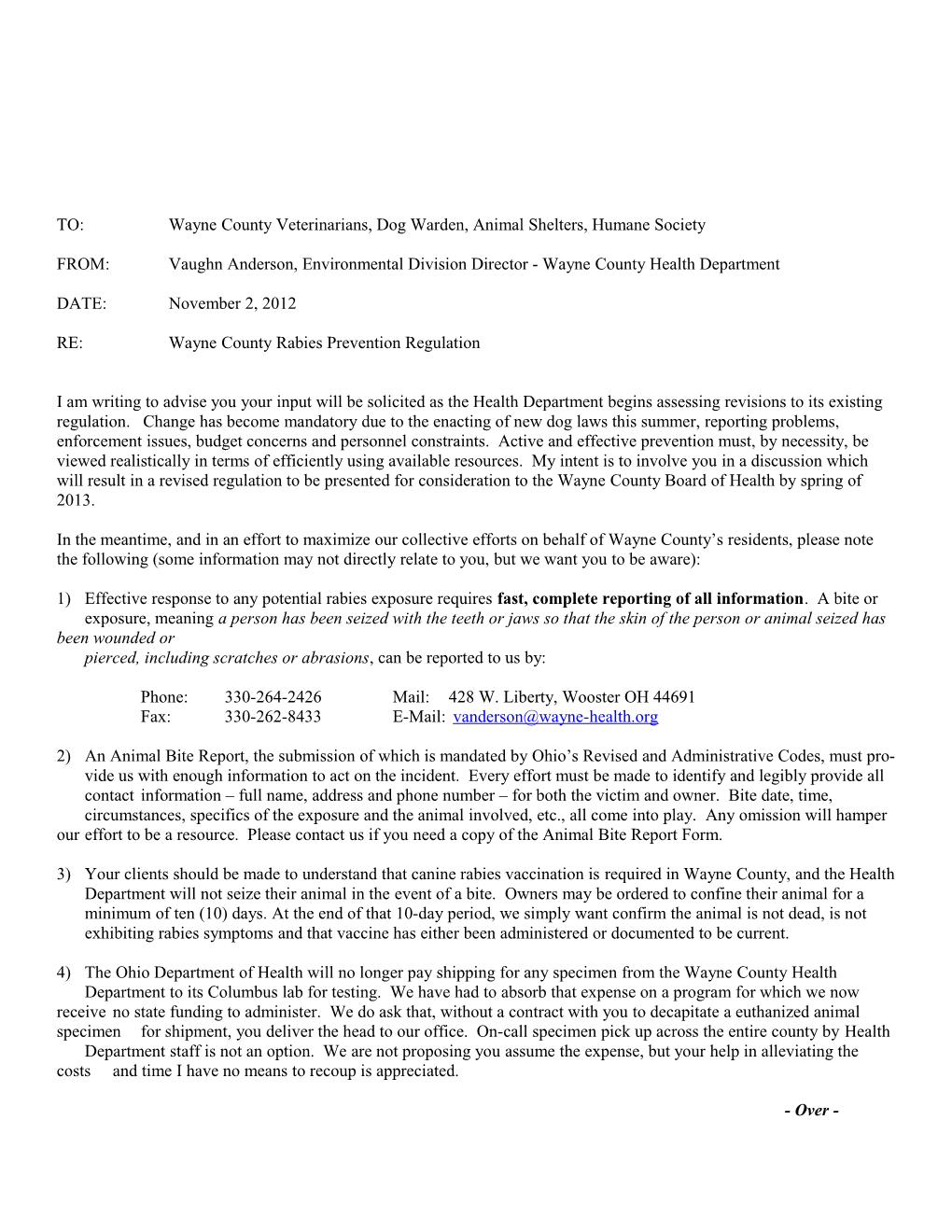TO:WayneCounty Veterinarians, Dog Warden, Animal Shelters, Humane Society
FROM:Vaughn Anderson, Environmental Division Director - Wayne County Health Department
DATE:November 2, 2012
RE:WayneCounty Rabies Prevention Regulation
I am writing to advise you your input will be solicited as the Health Department begins assessingrevisions to its existing regulation. Change has becomemandatory due to the enacting of new dog laws this summer, reporting problems, enforcement issues, budget concerns and personnel constraints. Active and effective prevention must, by necessity, be viewed realistically in terms of efficiently using available resources. My intent is to involve you in a discussion which will result in a revised regulationto be presented for consideration to the Wayne County Board of Healthby spring of 2013.
In the meantime, and in an effort to maximize our collective efforts on behalf of WayneCounty’s residents, please note the following (some information may not directly relate to you, but we want you to be aware):
1)Effective response to any potential rabies exposure requires fast, complete reporting of all information. A bite or exposure, meaning a person has been seized with the teeth or jaws so that the skin of the person or animal seized has beenwounded or
pierced, including scratches or abrasions, can be reported to us by:
Phone:330-264-2426Mail:428 W. Liberty, WoosterOH44691
Fax:330-262-8433E-Mail:
2)An Animal Bite Report, the submission of which is mandated by Ohio’s Revised and Administrative Codes, must pro-
vide us with enough information to act on the incident. Every effort must be made to identify and legibly provide all contact information – full name, address and phone number – for both the victim and owner. Bite date, time, circumstances, specifics of the exposure and the animal involved, etc., all come into play. Any omission will hamper our effort to be a resource. Please contact us if you need a copy of the Animal Bite Report Form.
3)Your clients should be made to understand that canine rabies vaccination is requiredin WayneCounty, and the Health Department will not seize their animal in the event of a bite. Owners may be ordered to confine their animal for a minimum of ten (10) days. At the end of that 10-day period, we simply want confirm the animal is not dead, is not exhibiting rabies symptoms and that vaccine has either beenadministeredor documented to be current.
4)The Ohio Department of Health will no longer pay shipping for any specimen from the Wayne County Health Department to its Columbuslab for testing. We have had to absorb that expense on a program for which we now receive no state funding to administer. We do ask that, without a contract with you to decapitate a euthanized animal specimen for shipment, you deliver the head to our office. On-call specimen pickup across the entire county by Health Departmentstaff is not an option. We are not proposing you assume the expense, but your help in alleviating the costs and time I have no means to recoup is appreciated.
- Over -
5)We will accept, properly pack, ship, track and pay any legitimate costs associated with the testing of any decapitated specimen head. Having saidthat, evaluation and discretion best utilizing the resources of everyone involved is to the benefit of all. We can all agree using the limited resources of a prevention program to euthanize and dispose of an unwanted animal,via the Health Department Rabies testing program, under the pretense of a possible bite, at no cost to the pet owner or the veterinarian, or because of a lack of space at a clinic or shelter, is as unacceptable as it is inhumane.
Owners of an apparently healthy house cat or family dog, current on its vaccination with minimal to no chance of having been exposed to rabies it can then transmit, can choose to honor the quarantine period for everyone’s safety. After that, retaining that animal in their home, or at an animal clinic at their cost, is their option. Euthanasia and decapitation costs should be borne by an owner who decides to put their pet down for testing prior to the end of the ten-day quarantine. During that ten days, it could have been proven – and is indeed highly statistically likely – that the animal was not rabid or a threat.
It is worth noting that from 2006 through 2011, the ODH lab tested a total of 11,391 cats and dogs, out of whichonly one incidence of canine rabies was confirmed statewide. Over that same six-year span, WayneCounty’s only identified positives involved four bat exposures.
Long-term, and with your active guidance and support, our goal is to assuring WayneCounty’s citizens are provided with information, education and technical expertise. Together, primarily with gaining widespread vaccination compliance, public health protection through rabies prevention is achievable. You are the front line, and the value of your experience and knowledge will be taken seriously.
If we can be of assistance or you have comments, please contact me at 330-264-2426, extension 204.
